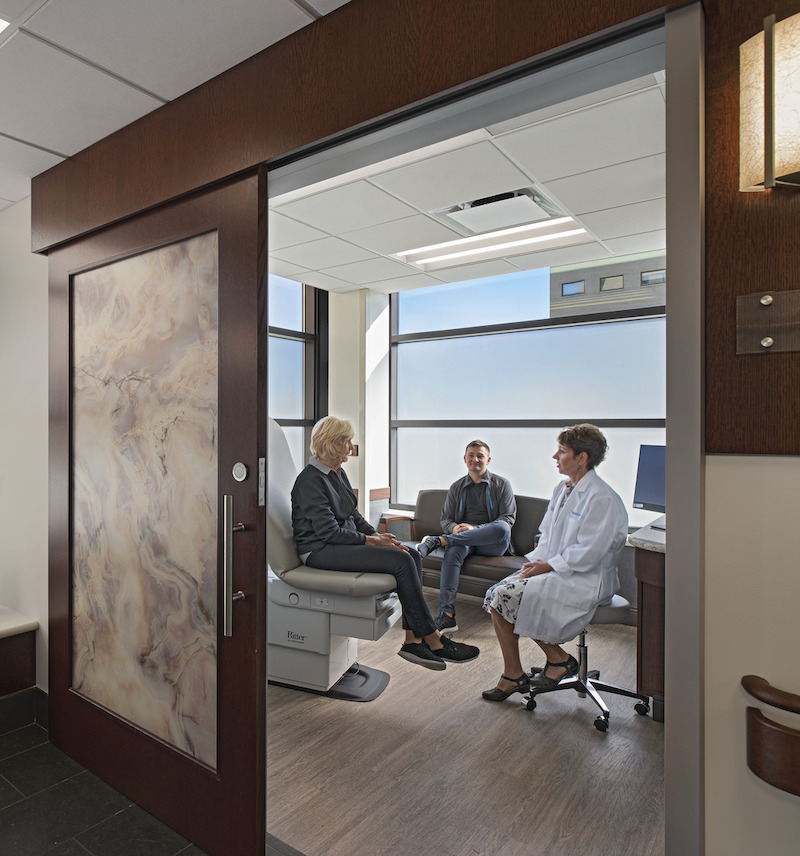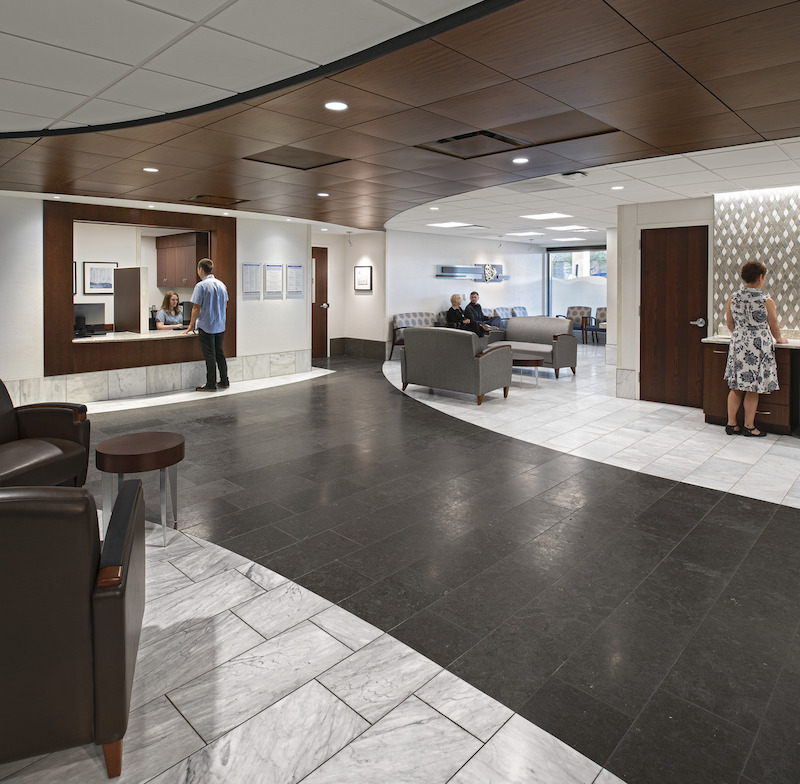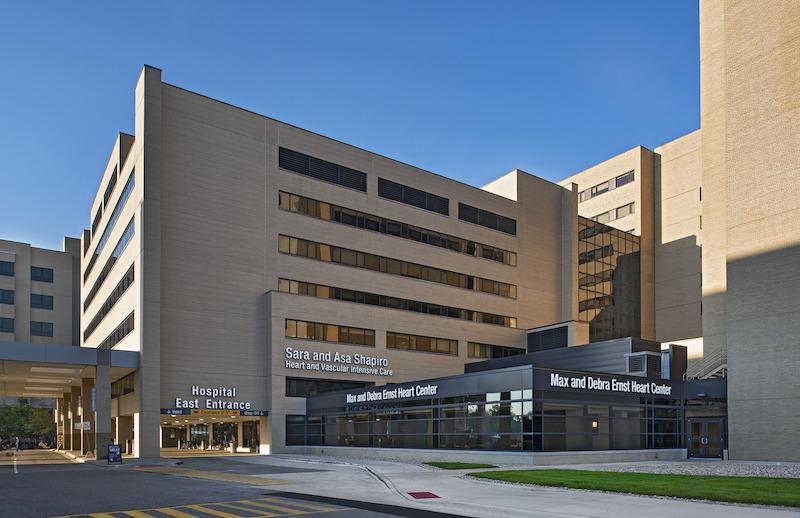This year, nearly 1.1 million Americas are expected to suffer “coronary events,” according to an American Heart Association report released earlier this year. The good news is that the number of deaths caused by cardiovascular heart failure or coronary heart disease has been falling steadily over the past several years.
That decline corresponds with the growth of heart failure clinics that have been popping up across the country, not only on academic campuses such as Stanford, Northwestern, Johns Hopkins, the University of Iowa and the University of Michigan, but also at major medical centers like Mayo Clinic (which has heart failure clinics in Arizona, Florida, and Minnesota), NYU|Langone Medical Center, and Cleveland Clinic.
Also see: 2019 Healthcare Giants Report: The ‘smart hospital’ is on the horizon
Add to that list the Max and Debra Ernst Heart Center, a $9 million, 14,000-sf facility that opened last month at Beaumont Hospital in Royal Oak, Mich. This addition, which is set up to treat 100 visitors per day, includes 12 patient care rooms, an echocardiogram room, a vascular room, a stress testing room, and two treatment rooms designed for outpatient medication infusion services.
The clinic is named after Max Ernst, the former Arbor Drugs COO, and his wife, who last year donated $5 million to the construction of the new heart failure center.
 The clinic, with 12 patient rooms, is set up to treat up to 100 visitors per day.
The clinic, with 12 patient rooms, is set up to treat up to 100 visitors per day.
David Jaeger, Principal, Healthcare Studio Leader, Harley EIllis Devereaux (HED), this project’s primary design architect, talked about the “scalability” of the clinics for treating heart failure. “That’s been the case for Beaumont for many years,” adding that the new clinic is about expansion and branding.
He says his firm has had a “longstanding relationship” with Beaumont, dating back to 1997. HED has also done a number of heart centers for other clients; Jaeger says this has become something of a specialty for the firm. On the Beaumont project, HED was also the SE, ME, EE, and landscape architect. PEA Inc. was the CE. And Kasco Construction was the CM.
Heart failure clinics: More than a heart hospital
The goal of heart failure clinics, he explains, is to keep more patients out of emergency rooms. He made the point, however, that cardiology in general is not a growing service anymore for hospitals. “You rarely hear about open-heart surgery anymore,” he says, noting the clinicians are doing a much better job, and have better tools, to treat patients so they don’t need major surgery. “Cardiovascular clinicians have to think about population health in a different what to grow and expand their businesses.”
 The clinic's glass facade lets in more natural light.
The clinic's glass facade lets in more natural light.
Jaeger says that this project was a challenge because the clinic needed to be wedged within five existing buildings on campus. It also needed to mediate radiation services below.
The precedent for heart failure clients that HED turned toward for its design, says Jaeger, was Duke University, which operates an advanced heart and lung failure clinic, a cardiology consult clinic, and a clinical research unit.
Beaumont is a 3 million-sf hospital, so patient access to the clinic was imperative. Located adjacent to the East Tower entrance of the hospital near the Ernst Cardiovascular Center that opened eight years ago, the clinic has its own entryway in close proximity to parking.
Jaeger also points out that, even though this campus’ buildings are mostly made from brick, HED specified a glass façade that wraps around the clinic addition, providing more natural light to patients and visitors.
Related Stories
| Aug 11, 2010
Gafcon announces completion of Coronado animal care facility
Gafcon, a leading California-based construction management and consulting firm, announced today that construction is now complete on a new $1.6 million animal care facility located at 1395 First Street in Coronado, Calif.
| Aug 11, 2010
Colorado hospital wins LEED Gold
The main building of the Medical Center of the Rockies in Loveland, Colo., is a 136-bed regional medical center offering a full spectrum of services, with specialties in cardiac and trauma care. Constructed primarily of brick, native sandstone, and 85,000 sf of metal panels manufactured by Centria, the 600,000-sf main building, by Denver-based HLM Design, is one of the few hospitals in the nati...
| Aug 11, 2010
Biomedical center to join London's research scene
The UK Centre for Medical Research and Innovation, a partnership of scientific organizations researching new treatments for illnesses such as cancer and heart disease, hopes to attract leading medical scientists to its planned research center. Designed by HOK London, the building will be located on 3.
| Aug 11, 2010
Design ups comfort, care in cancer center
A new cancer center is slated to open in fall 2011 at Banner Gateway Medical Center, Gilbert, Ariz. The three-story, 120,000-sf, $107 million cancer center will contain physician clinics, medical imaging, radiation oncology, infusion therapy, and support services. A/E firm Cannon Design has created a visually open, column-free interior to increase patient comfort and care.
| Aug 11, 2010
Charlotte hospital expands its surgery capabilities
The Chicago office of RTKL designed Carolinas HealthCare System's Mercy Medical Plaza, Charlotte, N.C. The 150,000-sf hospital houses 12 operating rooms with expanded pre-operative and recovery space, a pharmacy, and a central sterile processing unit. Tenant space occupies 75,000 sf. RTKL mimicked the materials and mass of older buildings on the campus but created a more modern look by using ex...
| Aug 11, 2010
And the world's tallest building is…
At more than 2,600 feet high, the Burj Dubai (right) can still lay claim to the title of world's tallest building—although like all other super-tall buildings, its exact height will have to be recalculated now that the Council on Tall Buildings and Urban Habitat (CTBUH) announced a change to its height criteria.
| Aug 11, 2010
East meets West in hospital design
The Los Angeles office of HMC Architects and the Chinese firm Shunde Architectural Design Institute won the commission to design the 2.15 million-sf First People's Hospital in the Shunde District of Foshan, China. The team's winning concept organizes a series of buildings around a dynamic, curved spine element to create an interior “eco-atrium” with outdoor green space and healing g...
| Aug 11, 2010
MOB added to new hospital project
A late-2009 ground breaking is planned for a $20 million medical office building on the grounds of the $211 million, 106-bed Loma Linda University Medical Center in Murrieta, Calif., which itself is under construction. Minneapolis-based Frauenshuh HealthCare Real Estate Solutions is developing the five-story, 160,000-sf MOB, which will accommodate 60 physician offices.
| Aug 11, 2010
Rehabilitation center helps patients transition
Construction is under way on the Polytrauma Transitional Rehabilitation Center on the VA Medical Center campus in Richmond, Va. The $8 million, 22,000-sf facility will provide physical therapy, housing, and education to veterans as part of their transition back into their communities. The center was designed by HDR, Alexandria, Va.
| Aug 11, 2010
Medical office building planned in Fort Worth, Texas
Dallas-based TGS Architects has unveiled its design for the five-story, 130,000-sf Plaza Medical Office Building, planned for Fort Worth, Texas. The Class A development will include space for orthopedic care, surgery, breast center, diagnostic imaging, cardiovascular, and rehabilitation therapy services.







